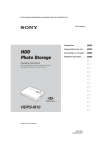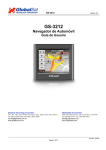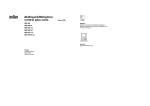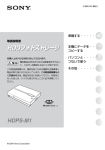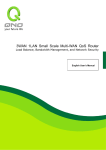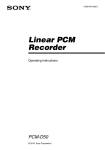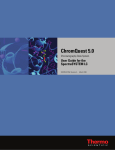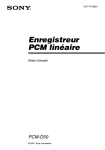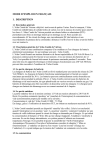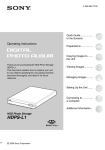Download Sony HDPS-M1 User's Manual
Transcript
2-022-121-11(1) Preparations _______________ Copying data to the unit _____ HDD Photo Storage Operating Instructions Before operating the unit, please read this document thoroughly, and retain it for future reference. EN OP HDPS-M1 © 2004 Sony Corporation Connecting to a computer ____ Additional information _______ Safety regulations WARNING Keep away from children. If swallowed, promptly see a doctor. To prevent fire or shock hazard, do not expose the unit to rain or moisture. To avoid electrical shock, do not open the cabinet. Refer servicing to qualified personnel only. Disclaimer Sony Corporation assumes no responsibility for the loss of information stored on the hard disk of this unit, or information transferred to a “Memory Stick” and/or CompactFlash card with your computer. • • • • • • • “Memory Stick”, , and “MagicGate Memory Stick” are trademarks of Sony Corporation. “Memory Stick Duo” and “ ” are trademarks of Sony Corporation. “MagicGate Memory Stick Duo” is a trademark of Sony Corporation. “Memory Stick PRO” and “ ” are trademarks of Sony Corporation. “Memory Stick PRO Duo” and “ ” are trademarks of Sony Corporation. “MagicGate” and “ ” are trademarks of Sony Corporation. Microsoft and Windows are registered trademarks of Microsoft Corporation in the United States and/or other countries. • Mac and Macintosh are trademarks of Apple Computer Inc., registered in the U.S. and/or other countries. • Microdrive is a registered trademark of Hitachi Global Storage Technologies. • Other system and product names used herein are registered trademarks or trademarks of their respective manufacturers, although the ™ and ® marks are not used in the text. In this manual, Microsoft® Windows® XP Professional and Microsoft® Windows® XP Home Edition are referred to as Windows XP. In this manual, Microsoft® Windows® 2000 Professional is referred to as Windows 2000. In this manual, Microsoft® Windows® Millennium Edition is referred to as Windows Me. 2 Table of contents What you can do with the HDD Photo Storage ............................................ 4 With a Macintosh computer ....... 33 Data storage locations and folder names ............................................ 35 Media types that can be used with the HDD Photo Storage ........................6 Using the unit as an external hard disk drive or reader/writer ............ 36 Safety regulations ........................... 2 About the “Memory Stick” media ............................................ 7 Recommended computer environment ....................................8 Identifying parts and controls ......... 9 Additional information Troubleshooting ........................... 37 Precautions ................................... 39 Maintenance ................................. 40 Preparations Unpacking .....................................12 Powering the unit ..........................13 Charging the battery ...................13 Using the unit with the AC power adapter ........................................14 Power save function ...................14 Disposing of the unit .................... 41 Specifications ............................... 42 Meaning of the indicators ............. 43 Remaingin battery/charging indications .................................. 43 Error indications ........................ 44 Copying data to the unit Inserting and removing the “Memory Stick” media .................15 Inserting and removing the CompactFlash card .......................17 Copying data to the HDD Photo Storage ..........................................19 Connecting to a computer Preparing the HDD Photo Storage and computer ................................22 Copying data to a computer ..........23 With Windows 2000 or Windows Me ...............................................23 With Windows XP ......................30 3 What you can do with the HDD Photo Storage Store lots of images from a digital camera! Simply take pictures, and then insert the media into the HDD Photo Storage to copy the image data to the internal hard disk. After copying, you can reuse the media immediately. The 40 GB hard disk of the HDD Photo Storage can store the equivalent of about 62 64 MB media. Remove Copy! EN OP Digital camera HDD Photo Storage Connect to a computer! Using the supplied USB cable, you can easily transfer data from an inserted media or from the hard disk of the HDD Photo Storage to a computer. There is no need to install any special software or perform a setup procedure. USB cable N OPE See the next page for a step-by-step guide. Use as an external hard disk! The HDD Photo Storage can function as a USB 2.0-compatible external hard disk, to provide data storage capacity to a computer. There is no need to install a dedicated driver, which is great for quick copying of data in a temporary setup. OPEN THE HDD Photo Storage can also be used as a card reader/writer. Take it anywhere! Thanks to its extremely compact dimensions and 300 g (10.6 oz.), the HDD Photo Storage is eminently portable, making it the ideal companion on any trip, long or short. 4 Copying images to your computer 1 2 3 Prepar the HDD Photo Storage and your computer (page 22). Copy image files to your computer (page 23). View images on your computer. 5 Media types that can be used with the HDD Photo Storage The following storage media can be used with the HDD Photo Storage. “Memory Stick” media “Memory Stick” types Read/write on HDD Photo Storage “Memory Stick” “Memory Stick” (with the Memory Select function) “Memory Stick Duo” Yes “Memory Stick” (MagicGate/High-speed transfer compatible) “Memory Stick Duo” (MagicGate/High-speed transfer compatible) Yes*1*2 “MagicGate Memory Stick” “MagicGate Memory Stick Duo” Yes*1 “Memory Stick PRO” “Memory Stick PRO Duo” Yes*1*2 *1 Read/write of data that requires the MagicGate function is not possible. *2 High-speed transfer using the parallel interface is supported only with the “Memory Stick PRO”. Transfer speed and available functions differ depending on the specifications of the respective equipment. CompactFlash cards (CF cards) • Type I, II • Microdrive Notes • There is no guarantee that the unit can use all “Memory Stick”, CompactFlash cards, or Microdrives. • The unit supports “Memory Stick” and Microdrives of up to 1 GB. Operation with “Memory Stick PRO” or Microdrives of higher capacities is not guaranteed. • Do not insert any media or devices other than those outlined above into the unit. 6 About the “Memory Stick” media The “Memory Stick” is a small, lightweight IC type storage media that can hold considerably more data than a conventional floppy disk. It can serve not only to exchange data between two devices with “Memory Stick” slots, but it is also convenient as a removable external media for data storage. The “Memory Stick” comes in two formats: the standard size “Memory Stick” and the smaller “Memory Stick Duo”. The unit is compatible with both formats. “Memory Stick” types There are six different types of “Memory Stick” designed for various applications. “Memory Stick PRO” This “Memory Stick” can only be used in equipment compatible with “Memory Stick PRO”. It incorporates a copy protection technology called MagicGate. “Memory Stick” This is the regular “Memory Stick”. It can store all kinds of data, except data that requires MagicGate copy protection. “Memory Stick” (MagicGate/High-speed transfer compatible) This type of “Memory Stick” incorporates the MagicGate copy protection and supports high-speed transfers. It can be used in all devices that support the “Memory Stick”. The unit does not support high-speed transfers. “MagicGate Memory Stick” This type of “Memory Stick” incorporates the MagicGate copy protection. “Memory Stick-ROM” This is a read-only type of “Memory Stick” that contains prerecorded data that cannot be deleted or overwritten. “Memory Stick” (with the Memory Select function) This “Memory Stick” has a number of separately addressable internal memory blocks (128 MB). The Memory Select switch at the rear of this type of “Memory Stick” lets you select the desired memory. It is not possible to use multiple blocks simultaneously or continuously. What is MagicGate? MagicGate is a copyright protection technology that must be present in the “Memory Stick” and on the device where it is to be used. MagicGate incorporates two security features: encryption of copy-protected data, and mutual verification of the “Memory Stick” and reader device. This serves to prevent the unauthorized copy and playback of copyrighted material. Because the HDD Photo Storage does not come with MagicGate, it cannot use data encrypted with MagicGate. 7 When you attempt to copy music files from a MagicGate device to a “Memory Stick”, the device and “Memory Stick” verify whether the other is MagicGate-compliant. Music files are only encrypted and copied if the verification is successful. Similarly, when attempting to play back encrypted files from the “Memory Stick”, playback only starts if the verification between the device and “Memory Stick” is successful. Recommended computer environment The unit can be used with computers that run the following preinstalled operation systems and come with USB ports. Windows • Windows XP Professional • Windows XP Home Edition • Windows 2000 Professional (Service Pack 4 or later) • Windows Me Notes • Even if the operating system is one of the above, operation is not guaranteed in a multiboot environment or if the operating system is an upgraded version. • Operation is not guaranteed when you use USB interface cards or USB CardBus cards added afterwards. Macintosh • Mac OS X (10.3 or later) 8 Identifying parts and controls 1 2 3 4 5 6 0 qa qs 9 8 7 qf qd A 1 e (power) indicator When the unit is on, this indicator lights or flashes. Depending on the remaining battery capacity, the indicator pattern changes. (page 14) B (“Memory Stick”) indicator (page 15) When you use the unit stand-alone and the “Memory Stick” is inserted, this indicator lights green. During copy, the indicator flashes. C CF (CompactFlash) indicator (page 17) When you use the unit stand-alone and a CompactFlash card is inserted, this indicator lights green. During copy, the indicator flashes. D (hard disk) indicator (page 19) Flashes green while the hard disk is being accessed. E COPY button (page 19) Serves to copy data from a “Memory Stick” or CompactFlash card to the internal hard disk. When the copy is ready, the button lights green. F Port cover (page 10) G ! (DC In) connector (page 13) Serves to connect the supplied AC power adapter. H (USB) port (page 22) Serves to connect the supplied USB cable. 9 I CANCEL/HDD CAPA. button (page 20) Serves to cancel an ongoing copy and verify the remaining hard disk capacity. J Eject button (page 17) Serves to eject the CompactFlash card. K Slot cover (page 10) L CompactFlash slot (page 17) Serves to insert a CompactFlash card. M “Memory Stick” slot (page 15) Serves to insert a “Memory Stick”. N ?/1 (power) switch (page 19) Serves to turn the unit on and off. O Hand strap hook Serves to attach the hand strap. Opening/closing the covers You can open/close the port and slot covers the same way. To open the covers Lightly push down the top part of the cover to open it, as illustrated. HD D 10 HD D HD D To close the covers Push the cover up from its fully open position, until the tab of the cover fits into the notch of the body. Then, lightly push up the cover until you feel it click into place. When it does, the cover is securely closed. Click Notes • Close the covers when the unit is not in use. • If the cover only opens as far as illustrated, you cannot close the cover. HDD To solve this problem, press the center of the cover as illustrated until it is in its fully open position, and then try closing it again. 11 B Preparations Unpacking When you unpack the unit, make sure that all the items listed below are present. If anything is missing, contact your dealer or an authorized service center in your area. • HDD Photo Storage unit (1) OPE • AC power adapter (1) (HDAC-M1) • USB cable (1) N • Power cord (1) • Indicator label (1) • Carrying case (1) • Hand strap (1) • Operating Instructions (this document) • PhotoDiary software (on the hard disk) • Read Me First (1) • Warranty card (1) Affixing the indicator label You can affix the indicator label anywhere on the unit, but we recommend that you affix it as illustrated below for easy reference. Indicator label OPE 12 N Powering the unit You can use the internal battery or the AC power adapter to power the unit. Charging the battery OW ER To the ! (DC In) connector To the AC outlet When the AC power adapter is connected to the unit, the internal battery starts charging. The 1 e (power) indicator flashes during charging. When the battery is fully charged, the indicator turns off. The charging process takes about 4 hours at ambient temperature. Hint The internal battery charges even when the unit is in use, as long as the AC power adapter is connected. However, the charge time is considerably longer than when the internal battery is charged as outlined above. Notes • Only use the supplied AC power adapter. Other power adapters do not work. • If you use the unit under battery power at temperatures of 10°C (50°F) or less, you cannot use the unit as long as normal. Normal operation of the unit under battery power is not guaranteed at low temperatures; therefore, make sure that you connect the AC power adapter. • To maintain battery performance, make sure that you charge it periodically by connecting the AC power adapter. 13 Preparations If you want to use the unit without the AC power adapter, you must first charge the internal battery of the unit. To do this, connect the supplied AC power adapter as illustrated. About the battery capacity If the unit is used on internal power, the battery charge is gradually depleted. The state of the battery charge is shown by the 1 e (power) indicator. The 1 e (power) indicator blinks during charging. If you charge the battery during use, the indicator blinks according to the following pattern: red, yellow, and then green. Remaining battery capacity Description Lit green 50% or more There is enough remaining charge in the internal battery to use the unit without connecting it to the AC power adapter, or the AC power adapter is connected to the unit. Lit yellow 10 to 50% The remaining charge is lowering, but still sufficient to copy several more media. Lit red Less than 10% Connect the AC power adapter to charge the internal battery. If you continue using the unit, it eventually turns off automatically. Flashing red Depleted The battery is depleted and needs to be charged. The indicator turns off when the battery is fully charged. Indicator Note The remaining of charge figures above are approximative. Actual results vary depending on the operating environment, number of times the battery is charged, etc. Using the unit with the AC power adapter You can use the unit without worrying about the remaining charge of the internal battery simply by connecting the AC power adapter. Connect the AC power adapter to the unit as outlined in “Charging the battery”(page 13). Power save function When the unit is used stand-alone, it turns off automatically after remaining idle for five minutes, whether operating on internal power or through the AC power adapter. Simply restart the unit to resume operation. 14 B Copying data to the unit Inserting and removing the “Memory Stick” media The “Memory Stick” slot of the unit can accept either a standard size “Memory Stick” or a “Memory Stick Duo”. The unit automatically detects what size of “Memory Stick” is inserted. There is no need to use an adapter when using a “Memory Stick Duo”. Hint Inserting the “Memory Stick” Insert the “Memory Stick” as illustrated, until you hear it click into place. CF The label should face up. Insert it in the v direction until you hear a click. When the unit is on, the “Memory Stick” is detected. (“Memory Stick”) indicator lights green as the Notes • Do not attempt to insert multiple “Memory Stick”. Otherwise, the equipment may be damaged. • Before use, double-check that the “Memory Stick” is inserted correctly. Otherwise, the equipment may be damaged. 15 Copying data to the unit For information on how to open and close the slot cover, see “Opening/closing the covers” (page 10). Removing the “Memory Stick” media Note Never remove the “Memory Stick” during copy. Otherwise, data may be corrupted. Push the “Memory Stick” all the way in, briefly release it, and then pull it out. When you push the “Memory Stick” all the way in, it slightly sticks out. CF CF Push in Release briefly and pull out 16 Inserting and removing the CompactFlash card Hint For information on how to open and close the slot cover, see “Opening/closing the covers” (page 10). Inserting the CompactFlash card MS The label should face up. Insert it in the v direction all the way into the slot. When the unit is on, the CF (CompactFlash) indicator lights green as the CompactFlash card is detected. Note Before use, double-check that the CompactFlash card is inserted correctly. Otherwise, the equipment may be damaged. Removing the CompactFlash card Note Never remove the CompactFlash card during copy. Otherwise, data may be corrupted. Push the eject button. The eject button sticks out. Push MS MS 1 Sticks out 17 Copying data to the unit Insert the CompactFlash card all the way into the slot, as illustrated. Push the eject button all the way in, release it, and then pull the CompactFlash card out. When you push the eject button in, the CompactFlash card slightly sticks out. Push in fully MS 2 MS Note Do not close the slot cover when the eject button is out. 18 Pull out Copying data to the HDD Photo Storage This section explains how to use the COPY button on the unit to copy data from a “Memory Stick” or CompactFlash card to the internal hard disk of the unit. Hint For information on how to connect the unit to a computer to copy, see “Connecting to a computer” (page 22). Notes 1 Turn on the unit. Push and slide the ?/1 (power) switch in the direction of the arrow. Hold the ?/1 (power) switch until the 1 e (power) indicator lights. Hold down and slide in the direction of the arrow Hint The color of the 1 e (power) indicator differs, according to the remaining charge of the internal battery. For details, see “About the battery capacity” (page 14). 2 Insert the “Memory Stick” or CompactFlash card into the unit (page 15, page 17). The media indicator, the (hard disk) indicator, and the COPY button light green. Example: When a “Memory Stick” is inserted 19 Copying data to the unit • The data read/write speed depends on the combination of “Memory Stick” and equipment. • Data from a “Memory Stick” that has the access control attribute set on another device cannot be read or copied on the unit. To enable reading and copying of such data, you must first disable the access control on the other device. • MagicGate-compatible data can be copied but not played back with the unit. Once MagicGate-compatible data is copied to the unit, it cannot be copied back to the “Memory Stick”, either. Notes • If the COPY button does not light green, an error has occurred. For details, see “Meaning of the indicators” (page 43). • When the unit is used stand-alone, it is not possible to insert both a “Memory Stick” and CompactFlash card, and copy data from both at the same time. Insert one media at a time. 3 Press COPY. CANCEL A folder is automatically created on the internal hard disk and the data is copied to that folder. While the copy is in progress, the media indicator, the (hard disk) indicator, and the COPY button flash in sequence. When the copy is done, the COPY button lights green. Note If the COPY button flashes red, the remaining space on the internal hard disk is insufficient to finish the copy. Connect the unit to a computer and use the computer to delete unnecessary data on the internal hard disk of the unit. For details, see “Deleting unnecessary files and folders” (page 35). Hint If you want to cancel the copy midway, press the CANCEL/HDD CAPA. button. The COPY button flashes red to prompt you to confirm that you want to cancel the copy. To cancel the copy, press the CANCEL/HDD CAPA. button once more. To continue the copy, press the COPY button. Even if you cancel the copy, the unit's capacity decreases slightly because folders are created on the internal hard disk of the unit. 4 Remove the media (page 16, page 17). Close the slot cover as necessary. Hint The COPY and CANCEL/HDD CAPA. buttons are only enabled when the unit is used standalone. When the unit is connected to a computer, both buttons are disabled. The COPY button can only be used when it is lit green. 20 To verify the remaining capacity of the internal hard disk Note You can only verify the remaining capacity of the internal hard disk when you use the unit stand-alone. Make sure that there are no media inserted into the drives of the unit. If there are, remove them. See page 16 to remove the “Memory Stick”. See page 17 to remove the CompactFlash card. 2 Press and hold CANCEL/HDD CAPA. The four indicators of the unit light for a moment, and then the remaining capacity of the internal hard disk is displayed as follows. 1e CF Capacity Lit green Lit green Lit green Lit green 20 GB or more − 3 Lit green Lit green Lit green 10 to 20 GB − − − − − − − − Lit green Lit green 5 to 10 GB Lit green 1 to 5 GB − 1 GB or less Release CANCEL/HDD CAPA. to resume normal operation. To turn off the unit Push and slide the ?/1 (power) switch in the direction of the arrow. The 1 e (power) indicator turns off when the unit does. The indicator continues flashing red when the internal battery is recharging. 21 Copying data to the unit 1 B Connecting to a computer Preparing the HDD Photo Storage and computer This section describes how to connect the unit to a computer using the USB cable to transfer data between the two devices. Hints • When the unit is connected to a computer, you can insert a “Memory Stick” and a CompactFlash card at the same time and access data from both. • When the unit is connected to a computer for the first time, the necessary programs are installed automatically. 1 Turn on the computer. 2 Turn on the unit. When the unit turns on, the 1 e (power) indicator lights. 3 Open the port cover on the right side of the unit and connect the supplied USB cable to the (USB) port. Connect the other end of the cable to the USB port of your computer. To the AC outlet 1 To the (USB) port 2 To the USB port of your computer Note Correct operation is not guaranteed when the unit is connected to a USB hub. Establish a direct USB connection. 4 Insert a “Memory Stick” and/or CompactFlash card into the unit as necessary. Hint When you connect the unit to your computer, the internal battery automatically charges whether the unit is on or off. However, to maintain battery performance, make sure that you charge it periodically by connecting the AC power adapter. 22 Copying data to a computer When the unit is connected to a computer using the USB cable, data on the internal hard disk of the unit, as well as the one on an inserted “Memory Stick” or CompactFlash card, can be managed by the computer. To illustrate, this section explains how to copy data from the unit to the “My Documents” folder of a computer running Windows. Copying data from the computer to the unit also uses a similar procedure. Note When the unit is connected to a computer with the USB cable, the COPY and CANCEL/HDD CAPA. buttons on the unit are disabled. Connecting to a computer With Windows 2000 or Windows Me 1 Double-click [My Computer]. The “My Computer” window opens. 23 In the “My Computer” window, the “Memory Stick”, CompactFlash card, and internal hard disk of the unit appear as follows. “Memory Stick” CompactFlash card Internal hard disk of the unit Hints • The “Memory Stick” and CompactFlash drives of the unit appear as removable disks, while the internal hard disk of the unit appears as a local disk. The drive letters (e.g., “E:”) differ depending on the computer system. • If no removable disks or the internal hard disk of the unit appear, refer to “When the drives of the HDD Photo Storage do not appear on the computer” (page 27). 2 24 Double-click [Local Disk (E:)]. The contents of the internal hard disk of the unit are shown. 3 Double-click [STORE.IPS]. 4 Double-click the folder that contains the files you want to copy to the computer. 5 Right-click the file that you want to copy and click [Copy] on the shortcut menu that appears. 6 Double-click [My Documents] on your desktop. 25 Connecting to a computer Files and folders on the internal hard disk of the unit appear. For details about folder names, see “Data storage locations and folder names” (page 35). 7 Right-click anywhere in the “My Documents” window and click [Paste] on the shortcut menu that appears. The selected file is copied to “My Documents”. If a file with the same name already exists in the destination folder A message prompting you to confirm whether you want to overwrite the existing file appears. If you overwrite the existing file, it is irrevocably lost, as it is replaced by the new file. To copy the new file without overwriting the existing file with the same name, save the new file under a different name. Disconnecting the USB cable from the computer or removing media 26 1 Click 2 Click [Stop USB mass storage device - drive (X:)]. 3 Make sure that the drive letter is correct and click [OK]. 4 Click [OK]. 5 Disconnect the USB cable. Remove the “Memory Stick” or CompactFlash card. on the Windows taskbar. When the drives of the HDD Photo Storage do not appear on the computer With Windows 2000 1 Right-click [My Computer] and click [Properties] on the shortcut menu that appears. Connecting to a computer The “System Properties” dialog box appears. 2 Verify that no other devices are shown. If other devices are shown, delete them. 1 On the [Hardware] tab, click [Device Manager]. 27 2 Make sure that “USB Mass Storage Device” is displayed as a . If it is, right-click it and click [Remove] on the shortcut menu that appears. Perform the same operation for “Disk drives”. The “Confirm Device Removal” dialog box appears. 3 Click [OK]. The device is removed. After the device is removed, disconnect the USB cable, and then reconnect it. With Windows Me 1 Right-click [My Computer] and click [Properties] on the shortcut menu that appears. The “System Properties” dialog box appears. 28 2 Verify that no other devices are shown. If other devices are shown, delete them. 1 On the [Device Manager] tab, make sure that “USB Mass Storage Device” is displayed as a . If it is, right-click it and click [Remove] on the shortcut menu that appears. Perform the same operation for “Disk drives”. Connecting to a computer The “Confirm Device Removal” dialog box appears. 2 Click [OK]. The device is removed. After the device is removed, disconnect the USB cable, and then reconnect it. 29 With Windows XP When connecting the unit with the USB cable to a computer running Windows XP, the AutoPlay wizard appears. 1 Click [Cancel]. 2 On the [Start] menu, click [My Computer]. The “My Computer” window appears. 30 In the “My Computer” window, the “Memory Stick”, CompactFlash card, and internal hard disk of the unit appear as follows. Connecting to a computer CompactFlash card Internal hard disk of the unit “Memory Stick” Hint The “Memory Stick” and CompactFlash drives of the unit appear as removable disks, while the internal hard disk of the unit appears as a local disk. The drive letters (e.g., “G:”) differ depending on the computer system. 3 Double-click [Local Disk (G:)]. The contents of the internal hard disk of the unit are shown. 4 Double-click [STORE.IPS]. 31 Files and folders on the internal hard disk of the unit appear. For details about folder names, see “Data storage locations and folder names” (page 35). 5 Double-click the folder that contains the files you want to copy to the computer. 6 Right-click the file that you want to copy and click [Copy], on the shortcut menu that appears. 7 On the [Start] menu, click [My Documents]. 8 Right-click anywhere in the “My Documents” window and click [Paste] on the shortcut menu that appears. The selected file is copied to “My Documents”. 32 If a file with the same name already exists in the destination folder A message prompting you to confirm whether you want to overwrite the existing file appears. If you overwrite the existing file, it is irrevocably lost, as it is replaced by the new file. To copy the new file without overwriting the existing file with the same name, save the new file under a different name. Disconnecting the USB cable from computer or removing media 1 Click 2 Click [Safely remove USB mass storage device - drive (X:)]. 3 Make sure that the drive letter is correct and click [OK]. 4 Disconnect the USB cable. Remove the “Memory Stick” or CompactFlash card. on the Windows taskbar. Connecting to a computer With a Macintosh computer When the unit is connected to a Macintosh computer with the USB cable, icons for the internal hard disk of the unit and the media appear on the desktop. The icons for the media appear when you insert a “Memory Stick” or a CompactFlash card into the unit. 1 Double-click one of the newly added icons on the desktop. Internal hard disk of the unit CompactFlash card “Memory Stick” The contents of the selected drive appear. 33 2 Double-click [STORE.IPS]. Files and folders on the internal hard disk of the unit appear. For details about folder names, see “Data storage locations and folder names” (page 35). 3 Double-click the folder that contains the files you want to copy to the computer. 4 Drag the file to the hard disk icon. The file is copied to the hard disk. Removing media Drag the “Memory Stick” or CompactFlash card icon to the trash. Disconnecting the USB cable 34 1 Drag all the media icons and the internal hard disk drive icon to the trash. 2 Disconnect the USB cable from your computer. Data storage locations and folder names Data copied to the internal hard disk of the unit is stored according to the following rules. Internal hard disk STORE.IPS The folder name is the date of the newest file copied Data and folders Data and folders Hints • Each time data is copied, a new folder is created. The name of the folder is always the creation date of the newest file copied from the media. For example, if the newest file copied from the media was created 2004/03/01, the folder name becomes “20040301.001”. If you copy other data with the same name as on the internal hard disk drive, the folder name extension augments incrementally: “.002”, “.003”, etc. • If a file has no date, it is saved in a folder named “19800000.001”. Deleting unnecessary files and folders With Windows Right-click the file or folder that you want to delete, and then click [Delete] on the shortcut menu that appears. Alternately, you can drag the file to the recycle bin. With a Macintosh computer Drag the file or folder that you want to delete to the trash. 35 Connecting to a computer The folder name is the date of the newest file copied Using the unit as an external hard disk drive or reader/writer The unit can be used as a USB-compatible external hard disk, functioning as a portable medium for data storage. The unit can also be used as a reader/writer of the “Memory Stick” or CompactFlash cards. Notes • When you use the unit as an external hard disk, the space available to copy data from a “Memory Stick” or CompactFlash card decreases according to the amount of data written to the disk. If there is not enough space to copy files, delete unnecessary data. • Do not format the internal hard disk of the unit with Windows or your Macintosh computer. In particular, if formatted with Windows NTFS, you will no longer be able to use the unit. If you partition the internal hard disk of the unit, make sure that the file system of the first partition is FAT32. • If you retouch images, change their names or change folder names of data on a “Memory Stick” or CompactFlash card with your computer, you may no longer be able to view them on a digital still camera. Hint When the unit is connected to a computer, the unit is used to exchange data with the computer, as well as between the “Memory Stick” and CompactFlash card. Note on formatting a “Memory Stick” If you want to format a “Memory Stick” with Windows, download the Memory Stick Formatter from the following address: http://www.sony.net/Products/mssupport/ 36 B Additional information Troubleshooting This section provides information related to the most common problems encountered by users of this product and their solutions. Check the points listed here before contacting your dealer or an authorized service center. Also refer to the documentation of your computer. Hint If the internal battery needs charging or if an error occurs while using the unit, the four indicators and COPY button on the front of the unit show the current condition. For details on lighting patterns, see “Meaning of the indicators” (page 43). Battery/power supply Cause/remedy The unit does not start. c The internal battery may be depleted. Connect the AC power adapter and charge the battery (page 13). The unit turns on briefly, but then turns off again. c Even when the internal battery is fully charged, it gradually loses charge if the unit is not used for an extended period of time, which can lead to reduced operating time. If you do not use the unit for a while, charge it before using the unit. c When the unit is shipped, the internal battery is not fully charged. It may therefore be empty by the time you receive it. c When using the unit on internal power at low temperatures, usage time may be radically reduced (page 13). c The performance of the internal battery gradually deteriorates, depending on the number of times it is charged, usage time, and storage period. Therefore, operating time may be reduced even if the battery is fully charged. This may mean that the battery needs to be replaced. Contact your dealer or an authorized service center regarding battery replacement. The unit turns off unexpectedly. c When the unit is used stand-alone, it turns off automatically after remaining idle for five minutes, whether operating on internal power or through the AC power adapter. Restart the unit (page 19). 37 Additional information Symptom Copying data to the HDD Photo Storage Symptom Cause/remedy Cannot copy. c Verify that the “Memory Stick” or CompactFlash card is inserted correctly and detected by the unit. When detected correctly, the respective media indicator lights green. c Verify that a “Memory Stick” and CompactFlash card are not inserted in the unit simultaneously. If so, remove one. c Verify that the COPY button is lit green. c Verify whether there is enough free space on the internal hard disk. If necessary, delete unnecessary data (page 35). c Verify that the internal battery has an adequate remaining charge (page 14). Using the HDD Photo Storage with a computer Symptom Cause/remedy Cannot copy. c Verify that the unit is properly connected to the computer with the USB cable. If so, the drive of the unit is displayed on the computer screen (page 22). Cannot use the COPY button. c When the unit is connected to a computer, the COPY button is disabled. Cannot copy computer data to a c Verify whether the “Memory Stick” is writeprotected. “Memory Stick” or c Verify whether there is enough free space on the CompactFlash card. “Memory Stick” or CompactFlash card, or if they are formatted. 38 Precautions Usage and storage “Memory Stick” media Notes on using “Memory Stick” media • When you set the “Memory Stick” write-protect switch to “LOCK”, data cannot be written, edited, or deleted. Terminal Overheating Write-protect switch If the unit has become hotter than normal during operation, turn off the unit, disconnect the AC power adapter, and then contact an authorized service center. Label area Condensation If the unit is brought from a cold to a warm location, or if the ambient temperature suddenly rises, moisture may form on the outer surface and in the interior of the unit. Do not use the unit in such a condition, as this can cause damage. If condensation has occurred, leave the unit for about an hour without turning it on. Hard disk • Never disconnect a cable or turn off the computer or unit while data is being written to or read from the hard disk. Otherwise, data may be corrupted or lost. Sony Corporation does not accept any liability for damage caused by data loss. Additional information • Only use the specified AC power adapter. • Never short-circuit any of the connectors using a metallic object such as a keyholder. • Do not leave the unit in locations where the temperature may rise above 60°C (140°F), such as in a closed car or in direct sunlight. • Protect the unit from water and moisture. • Use the unit on a flat level surface. • Turn off the unit before carrying it. • Hard disks can hold a vast amount of data, but damage or malfunction can lead to sudden and irreplaceable data loss. It is highly recommended to regularly back up the contents of the hard disk. Sony Corporation does not accept any liability for damage caused by data loss. • • • • The position and shape of the writeprotect switch may differ between the various types of “Memory Stick”. Do not remove the “Memory Stick” while it is reading or writing data. Data may be damaged if: – The “Memory Stick” is removed or the unit is turned off while reading or writing. – You use the “Memory Stick” in a location subject to the effects of static electricity or electric noise. We recommend that you back up important data recorded on the “Memory Stick”. Do not affix anything other than the supplied label to the “Memory Stick” label area. 39 • Affix the label so that it does not stick out beyond the label area. • When storing or carrying a “Memory Stick”, keep it in its original case. • Do not touch the terminal of the “Memory Stick” with anything, including your fingers or metallic objects. • Do not strike, bend, or drop the “Memory Stick”. • Do not disassemble or modify the “Memory Stick”. • Do not allow the “Memory Stick” to get wet. • Do not use or store the “Memory Stick” in locations subject to: – Extreme heat, such as in a closed car parked in the sun. – Direct sunlight. – Humidity or corrosive substances. Notes on using “Memory Stick Duo” • Use a pointed object, such as a ballpoint pen, to move the “Memory Stick Duo” write-protect switch. • Do not write forcefully on the “Memory Stick Duo” memo area. Terminal • Make sure that the Memory Select switch is properly positioned to the side. When the switch is not positioned properly, the unit may be damaged or malfunction. • Before inserting the “Memory Stick” in the slot of the unit, make sure that the memory you want to use is already selected. • A “Memory Stick” with the Memory Select function allows the user to select the internal memory of the “Memory Stick” with the selector switch. Care must be taken in the following cases as the supported devices only detect the selected memory: – Formatting is only processed for the selected memory. – The remaining memory is only indicated for the selected memory. – The error display is only served for the selected memory. It is detected separately from the unselected memory. Maintenance Cleaning the cabinet Write-protect switch Memo area Notes on using the Memory Select function • You cannot use multiple memory blocks simultaneously or continuously. • Never operate with the Memory Select switch when the “Memory Stick” is inserted in the slot of the unit as it may cause damage. Sony Corporation does not guarantee such failure resulted from the above operation. 40 Wipe the outside of the unit with a soft, dry cloth. To remove stubborn stains, moisten the cloth with a mild, neutral detergent. Do not use solvents, cleaning alcohol, benzene, or other substances that may damage the finish. Disposing of the unit Extract the tape from the inside of the unit with an elongated object, as illustrated. 4 Grab the extracted tape and partially pull the battery out of the unit. 5 Disconnect the battery cable. Removing the internal battery 1 Disconnect the AC power adapter and USB cable from the unit. 2 Use a Phillips screwdriver to remove the screw on the side of the unit. You can see a tape on the side of the battery. EN OP 41 Additional information Before disposing of the unit, the internal battery must be removed as described below. If you want the internal battery replaced, contact your dealer or an authorized service center. In this case, you do not need to remove the internal battery beforehand. To prevent the risk of damage and/or injury, never use any other battery except the one integrated in the unit. Do not remove the side panel or the internal battery of the unit unless you are about to permanently dispose of the unit. 3 6 Remove the internal battery. EN OP Connector USB (mini-B) × 1 Power supply Lithium-ion rechargeable battery (internal) 100 - 240 V AC, 50/60 Hz Power consumption 7.5 W maximum Notes • The interior of the unit may become hot during operation. Before removing the internal battery, make sure that the unit has cooled down. • Take care that no foreign object enters the unit while the internal battery is removed. • Do not reinstall the internal battery into the unit once removed. • When disposing of the internal battery, make sure that you conform to your local regulations. Ambient conditions Operating temperature: 5°C to 40°C (40°F to 104°F) (temperature gradient less than 10°C/hour (50°F/hour)) Operating humidity: 20% to 80% (non-condensing) Dimensions Approx. 135 × 30 × 92 mm (5 3/8 × 1 3/16 × 3 5/8 in.) (W × H × D) Mass Approx. 300 g (10.6 oz.) Specifications HDPS-M1 Storage capacity 40 GB (Formatted with FAT32. 1 GB amounts to 1,000,000,000 bytes.) Media slots “Memory Stick” slot × 1 CompactFlash slot × 1 Supported media See page 6. Interface USB 2.0 (Hi-Speed/Full-Speed)* * If the connected computer does not support USB 2.0, transfer speed will be according to Full-speed USB (12 Mbps). 42 Supplied accessories AC power adapter (HDAC-M1) (1) Carrying case (1) Hand strap (1) Indicator label (1) Operating Instructions (this document) PhotoDiary software (on the hard disk) Power cord (1) Read Me First (1) USB cable (1) Warranty card (1) Design and specifications are subject to change without notice. Meaning of the indicators The four indicators and the COPY button of the unit provide information about the state of the internal battery and errors that occur during operation. Use the tables below to determine the meaning of the lighting patterns and appropriate actions. Remaingin battery/charging indications Remaining battery capacity Description Lit green 50% or more There is enough remaining charge in the internal battery to use the unit without connecting it to the AC power adapter, or the AC power adapter is connected to the unit. Lit yellow 10 to 50% The remaining charge is lowering, but still sufficient to copy several more media. Lit red Less than 10% Connect the AC power adapter to charge the internal battery. If you continue using the unit, it eventually turns off automatically. Flashing red Depleted The battery is depleted and needs to be charged. The indicator turns off when the battery is fully charged. Indicator 43 Additional information The 1 e (power) indicator shows the charge of the internal battery. The 1 e (power) indicator blinks during charging. If you charge the battery during use, the indicator blinks according to the following pattern: red, yellow, and then green. Error indications If an errors occur when using the unit, the indicators light in certain patterns, as outlined below. When this happens, press the CANCEL/HDD CAPA. button to cancel the error, and then take the appropriate action. Errors during initialization Lighting pattern CF COPY Action Lit green − − Lit yellow Format the “Memory Stick”. Lit green − − Lit red The “Memory Stick” may be damaged. Use a different “Memory Stick”. − Lit green − Lit yellow Format the CompactFlash card. − Lit green − Lit red The CompactFlash card may be damaged. Use a different card. Lit green Lit green − Lit yellow Eject the “Memory Stick” or CompactFlash card. − − Lit green Lit yellow Format the internal hard disk drive on FAT32. − − Lit green Lit red Contact your dealer or an authorized service center. Errors during copy Lighting pattern CF 44 COPY Action Blinking green − − Lit yellow Press the COPY button again to restart the copy. Blinking green − − Lit red Reinsert the “Memory Stick”. If the error persists, use a different “Memory Stick”. − Blinking green − Lit yellow Press the COPY button again to restart the copy. − Blinking green − Lit red Reinsert the CompactFlash card. If the error persists, use a different CompactFlash card. − − Blinking Blinking The number of folders with the same name has reached its maximum (999). Delete some green yellow folders of the same name (page 35). − − Blinking green − − Blinking Blinking There is not enough free space on the internal hard disk. Delete any unnecessary data to free green red space (page 35). − − Blinking green Lit yellow Lit red Press the COPY button again to restart the copy. Contact your dealer or an authorized service center.













































